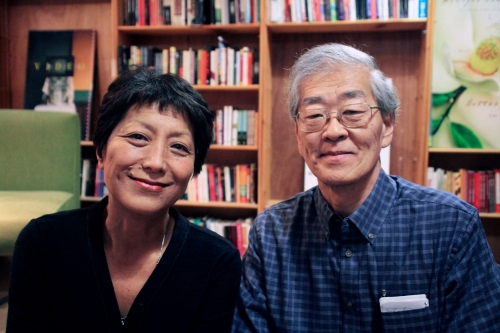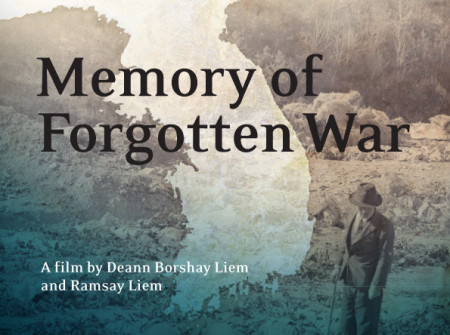
By
One of the ironies of referring to the Korean War as “the forgotten war,” says Professor Emeritus of Psychology Ramsay Liem, is that it technically has never ended, since no formal treaty between the antagonists has ever been signed.
But for many Koreans, the war is not forgotten, says Liem, co-producer and co-director of a recent documentary that depicts the human costs of military conflict through personal accounts by four Korean-American survivors.
“Memory of Forgotten War,” which Liem produced and directed with his sister-in-law Deann Borshay Liem, was shown at Boston College earlier this month. The program also featured a Q&A with the filmmakers and cultural music and dance presentations that included BC student performers.
“As Koreans, so much of our lives are influenced by the war, no matter where we are from,” says Liem, who was born in the US of parents who had left Korea in the 1930s. “There needs to be an appreciation of the profound complications in this war, and how these affected generations of Koreans. Most of all, there has been a silence about the war among us, even within families. This film is an attempt to get conversations started, or at the very least to bring these stories of people’s lives to our community and the wider public.”
The 38-minute film provides some historical and political context for the war, such as the Japanese occupation of Korea, the post-World War II division of the peninsula at the 38th parallel by the US and Soviet Union, and the ensuing three-year US Army military government in the South. It also touches on the conflict’s major events, including the Battle of Inchon, the entry of China and the negotiations for an armistice, and on some of its aftermath – Korean immigration to the US, North-South relations, and reunion visits between relatives on opposite sides of the border.
But the four survivors are at the core of the film. Their recollections, by turns stoic, poignant and heart-wrenching, point up a human cost beyond death or destruction of property. Military, political and geographical factors uprooted people and divided families, as battle lines shifted constantly. The fates of relatives and loved ones might be unknown for years, or never determined. Political polarization during and after the war has often exacerbated a quashing of ideals, even identity.

Suntae Chun, a native of the border town of Kaesong, recalls a school outing on the very eve of the war’s outbreak in 1950. One day, he’s swimming in a reservoir with his friends; the next day, he awakes to bullets dropping in the water and the sound of machine guns and mortar fire, and discovers Kaesong is occupied by the North Korean army. When Kaesong is later sealed off for peace talks, Chun is left on the outside while his father is trapped inside the city; he never sees his father again.
Kee Park, whose mother used silver spoons and chili powder to bribe guards into allowing them to cross to the South, accompanies her in an ultimately futile quest to find out what happened to Park’s father, who had been captured during the North’s initial invasion.
Because one’s loyalty could be suspect if a family member was on the “wrong side” of the border, disavowing his or her very existence was often a means to survive. Such is the experience of Minyong Lee, who sees three of his siblings move to the North and thus draws scrutiny from South Korean authorities. Even after the war, among friends and acquaintances, he seldom discusses his family or background: “I would be immediately ostracized by Korean society,” he says. “I hide everything about me, my identity. I hide myself.”
Vivacious, animated Hee Bok “Grandma” Kim – in one scene she demonstrates how, as a child, she would use peanuts as earrings, and in another offers food to the film crew – talks of living in a hakkobang, or cardboard house, for three years as the war drags on. When the armistice is signed, she is able to go to Seoul, but her parents and siblings are in the North.
Although Liem and his parents were in the US at the outbreak of the war, they were not spared its impact: Most of the family remaining in Korea were, and still are, in the North; it was not until many years later that reunion visits were allowed, and familial bonds could be reestablished.
“Memory of Forgotten War,” which is funded partly through the Massachusetts Humanities Foundation, builds upon an oral history project and accompanying multi-media exhibit, “Still Present Pasts: Korean Americans and the ‘Forgotten War,’” Liem created about a decade ago. Much like that enterprise, the film’s website includes resources to help spur further exploration of the Korean War and other related topics.
Liem traces the inspiration for these projects to his familiarity with torture and abuse victims in Latin America. He saw a commonality in the struggles of the Latin American and Korean survivors to deal with their experiences in the face of pervasive silence and forgetting.
“An important part of the healing process is to be able to talk about, to externalize, what you’ve been through,” he explains. “People can only speak about and share their stories in a ‘safe’ place: to an audience whose members are receptive and able to listen, and do not convey disbelief or their own vulnerability.
“As I thought about the collective silence on the Korean War I’d long observed, I wondered if it would be possible to create an environment where people could talk about what they had experienced, seen and heard – and if we could bring those stories back to the community. The idea is to create public spaces of memory that are safe in which to listen, talk and observe. ‘Memory of Forgotten War,’ like the oral history project and multimedia exhibit, is a step in that process.”
Liem has been able to work on his Korean projects with a certain amount of professional and scholarly detachment, but there have been emotional moments nonetheless. As “Grandma Kim” described the end of the Japanese occupation, and the hope of all Koreans for genuine independence and national sovereignty, he recalls, she paused and said, “When are we going to feel that again?”
“Everybody in the room started to cry,” Liem says.
Liem says “Memory of Forgotten War” does not advance a specific ideological view, although it is forthright about the US role in the division of Korea and conduct of the war. He advocates US willingness to engage in dialogue to replace the Korean War armistice with a peace agreement as a critical step toward enabling Koreans, from North and South alike, to share their stories and lives with one another and create their own path to reconciliation.
“Minyong Lee talks about his family reunion and says, ‘After I met my siblings, I then knew who I was.’ Grandma Kim, whose brother was killed by North Koreans, says there shouldn’t be a taboo about visiting North Korea: ‘Go a lot, dialogue, interact, learn. That’s what’s needed.’
“Koreans have so much to gain from sharing these memories, because they are part of us.”



